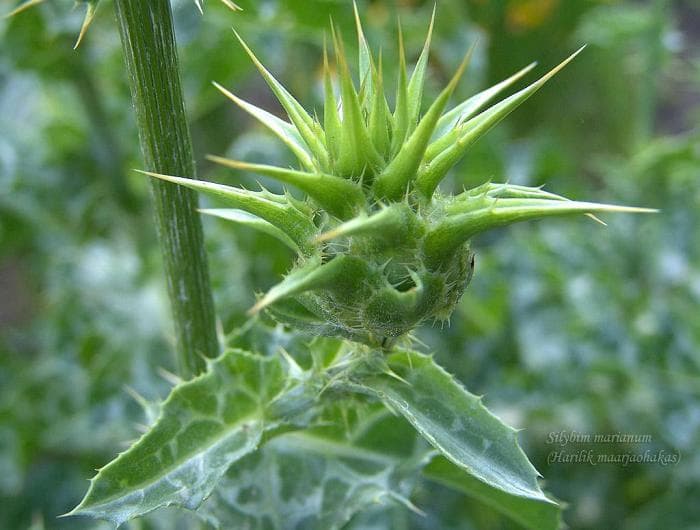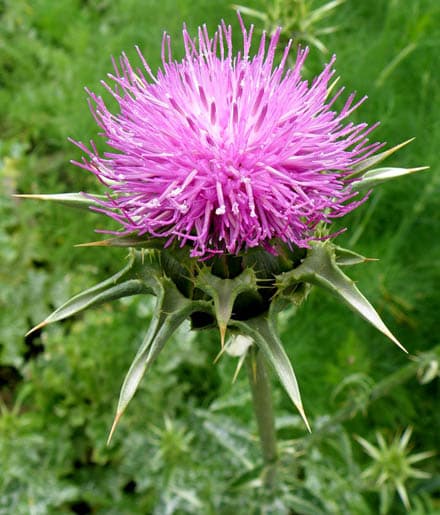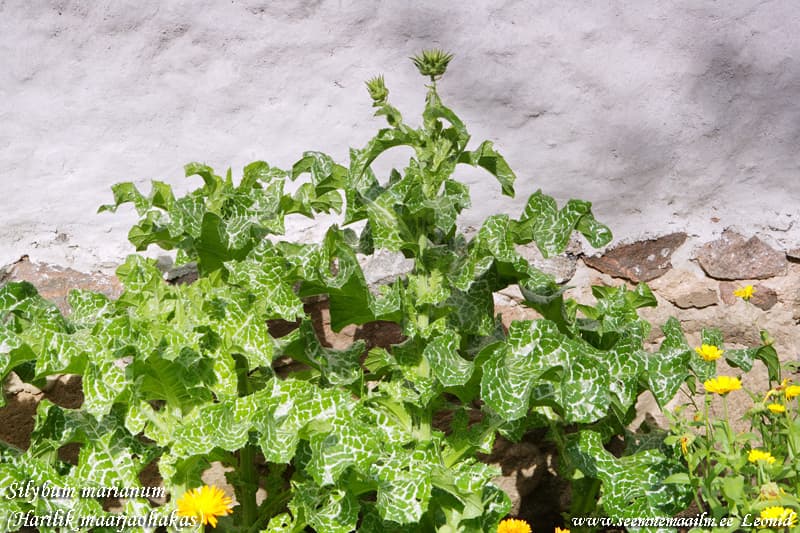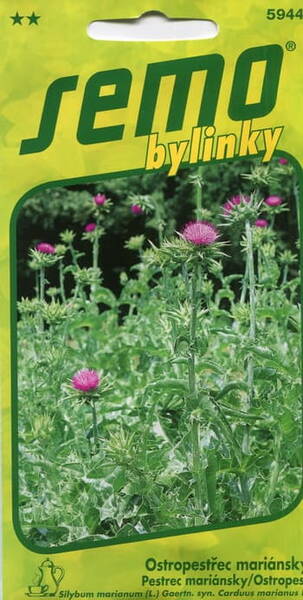Ex Tax: 1.45€
This thorny plant grows up to 2 meters in height, and the flowering heads at the top are bright purple.
This plant is native to Western and Central Europe; it also decorates the fields of America and Asia. In Scotland, this plant is a symbol of the country.
Milk thistle has been used as a medicine for thousands of years.
The history of its name can be read in the second word of the Latin name - Silybum marianum:
for the people who named this plant that way, the white stripes on its leaves were the milk of the Holy Virgin Mary...
Historical documents indicate that the ancient Greeks used an infusion of milk thistle fruit 2,000 years ago.
The Romans also knew about its beneficial properties and used it in the treatment of liver diseases.
In India, it is used in homeopathic and traditional medicine.
And in Europe, milk thistle extract has long been recommended for liver disorders such as hepatitis and cirrhosis.
In an ancient medical reference book, the Greek herbalist Dioscorides recommended milk thistle for many diseases.
And only in 1968, at the Munich Institute of Pharmaceutical Sciences, the biochemical composition of milk thistle was deciphered.
The main component of the medicinal plant milk thistle is a rare biologically active substance - silymarin,
In addition, trace elements such as zinc, copper, selenium, the entire group of fat-soluble vitamins, quercetin, polyunsaturated fatty acids, some amino acids, flavolignans were discovered - a total of about 200 biochemical components, which explains the multifaceted use of milk thistle.
Milk thistle is a plant for the treatment, first of all, of the liver, stomach, and intestines, although it has proven itself excellent for diseases of the skin, cardiovascular pathology, ear, throat, and nose.
Milk thistle can be used to solve a number of gynecological problems. It is also used in the treatment of hemorrhoids.
Healers love milk thistle for its absolute harmlessness, which is what distinguishes it from other herbs.
The active substance of milk thistle is silymarin (complex of flavonolignans - silibinin, etc.), which has a pronounced protective and restorative effect on liver cells, has an antioxidant, detoxifying (neutralizing toxins and poisons) effect.
Silymarin prevents the penetration of toxic substances into liver cells and decomposes other poisons before they begin to have their harmful effects.
Milk thistle is the only natural compound known today that protects liver cells and restores liver function.

Agrotechnics.
Milk thistle is propagated by sowing seeds at the growing site. Seedlings take root less well, since the taproot is easily damaged during transplantation, and the plant suffers for a long time, stunted in growth. It is better to use fresh seeds for sowing, as they quickly lose their viability when stored. Large milk thistle seeds with a thick shell should be soaked in water for several hours before sowing.
In a sunny place, larger baskets of flowers develop, and a seed yield from one plant is possible up to 200 g.
Before sowing, you need to dig up the soil using a spade, make holes at a distance of 50-60 cm, into which add a handful of humus, half a glass of ash and a tbsp. a spoonful of complete mineral fertilizer. Then mix everything with the soil, water it, and add 1-2 seeds into each hole to a depth of 2-3 cm.
Seeds sown in early May sprout within 7-14 days (depending on the weather).
Milk thistle tolerates cold temperatures up to +10 degrees in the rosette phase. It grows quickly, blooms in July-August, and the seeds ripen in September. Flowering of new baskets continues until frost. Flowers attract many bees and bumblebees.
The seeds are collected when the flowers turn into white tufts and the capsules begin to open. By this time, the growth of the plant may end, and the height may reach two meters. The bolls are cut off with a small “tail” of the peduncle, grasping it with tweezers or pliers, and laid out in a room for drying and ripening of the seeds.
Each seed has a tuft of white soft hairs on a stalk. Cleaned seeds are stored in a cool, dry place for no more than three years.
Seeds and roots serve as medicinal raw materials.
The seeds are collected in late August - early September, when the wrappers on most of the side baskets have dried.
Harvesting is carried out early in the morning, when the baskets have not yet blossomed. The collected raw materials are dried and cleaned of impurities.
Store in bags in well-ventilated areas for 1 year.
The roots are dug up in the fall, shaken off the ground, washed with cold water and dried in the sun or in a dryer at a temperature of +40+50 °C.
Store in a closed glass container for 1 year.
The seeds contain fatty oil (up to 32%), essential oil (0.08%), resins, mucus, vitamin K, tyramine, histamine, flavonoids,
as well as macro- and microelements: potassium, calcium, aluminum, vanadium, magnesium, manganese, copper, zinc, chromium, selenium, strontium, lead, etc.


Milk Thistle, blessed milkthistle, blessed milk-thistle, holy thistle, lady's thistle, Mary thistle, St Mary's milk thistle, variegated thistle. Pharm.: fructus silybi, semen cardui mariae. Bot. syn.: Carduus marianus L., Mariana mariana (L.) Hill.
Silybum marianum.
Used for diseases of the liver (hepatitis, cirrhosis) and spleen, cholelithiasis and inflammation of the bile ducts. The seeds contain: essential oil, resins, mucus, biogenic amines and flavonoids. The active ingredients improve metabolic processes in the liver, increasing its resistance to adverse conditions, increase the activity of liver enzymatic systems, accelerate the regeneration of liver cells after damage, toxic effects and infectious diseases. Seed harvesting is carried out at the end of summer.
Milk thistle tea: pour 1 teaspoon of seeds into ¼ liter of boiling water and leave for 20 minutes, take 1 cup hot in the morning on an empty stomach, half an hour before lunch and in the evening before bed.
* Living plant food is the food of God, cleansing a person in a natural and moral way, which gives him the opportunity to cleanse himself through independent efforts.
Traditional healers encourage the human body to heal with the help of medicinal plants containing many biologically active substances. In such cases, plants have a beneficial effect not only on individual organs, but also on the entire body as a whole.
That is why when doing herbal treatment, being in the fresh air, physical exercise, massage, medicinal baths, proper nutrition and good sleep are very important.
Ancient healers proceeded from the position that it was not the disease that should be treated, but the person. Their statement is still relevant today, because, as a rule, having lived the first half of life carefree, after forty years a person is forced to agree with the great German philosopher Arthur Schopenhauer, because he suddenly begins to clearly understand that “nine-tenths of human happiness depends on health.” And he begins to try to restore the health carelessly wasted in his youth...
He is looking for miraculous remedies that will help him return what he could not save. But, as you know, any event in a person’s life, as well as any illness, has its own causes and consequences. To establish this cause-and-effect relationship means to be half cured. Helping the body awaken its dormant protective forces and teach it to resist the onslaught of ill health means healing.
All parts of milk thistle have medicinal properties.
All parts of the plant are edible except the spines. The leaves can be used in salads, side dishes, and cold dishes. The main medicinal raw material of milk thistle is its seeds.
Thousands of years of human experience have shown that using milk thistle can successfully cure many ailments, including liver diseases: acute and chronic hepatitis, cirrhosis, jaundice, damage caused by alcohol, drugs, toxins and radiation.
A natural decoction of milk thistle not only protects the cell membranes of the liver, but also promotes the formation of new cells that strengthen this vital organ.
Milk thistle is used to treat cholecystitis, colitis, inflammation of the bile ducts, cholelithiasis, diseases of the spleen, thyroid gland, blood, salt deposits, diabetes, stomach ulcers, edema, dropsy, obesity, hemorrhoids, allergic diseases.
In dermatology, it is used to treat vitiligo, psoriasis, acne and baldness. Juice and decoction of the roots treat joint pain, radiculitis, inflammation of the colon, and gastric diseases.
The roots and seeds of milk thistle have a strong antiseptic effect and remove excess fluid and waste from the body. Milk thistle preparations increase the protective properties of the liver against infections and poisoning, stimulate the formation and excretion of bile, the secretory and motor functions of the gastrointestinal tract.
Milk thistle has no contraindications or side effects. Natural preparations made from it are much stronger than tablets. Therefore, before using milk thistle preparations and tablets, you should consult a doctor.
At home, you can prepare juice, root decoction, seed decoction and seed powder.
1. Freshly picked leaves are washed from dust and dirt, dried and juice is obtained using a juicer, which is drunk 1-2 tbsp. spoons in the morning on an empty stomach for diseases of the gastrointestinal tract. The juice is also used to treat radiculitis.
2. For a decoction of the roots, take 1 tbsp. a spoonful of dry or crushed fresh roots, pour a glass of water in an enamel bowl, steam for 30 minutes in a water bath, filter through 2-4 layers of gauze, bring to the previous volume with boiled water. Drink 1 teaspoon every 2 hours 5-6 times a day before meals: for jaundice, liver disease, diarrhea, cramps, urinary retention, edema, dropsy, hemorrhoids, also used as a rinse for toothache.
For radiculitis and joint diseases, make lotions with a decoction in places of pain.
3. For a decoction of seeds, take 30 g of seeds (2 tablespoons), grind into powder, pour in 0.5 liters of hot water, evaporate over low heat to half the volume of liquid, strain through 2-4 layers of gauze. Take 1 tbsp. spoon every hour all day. The course of treatment is 1-2 months. In case of severe illnesses, it can be repeated after 2-3 weeks. To treat the liver, you need to clean it according to Ilyin’s method with an infusion of oats with birch buds, lingonberry leaves, rose hips, knotweed grass and corn silk.
4. Dry seed powder take 1 spoon 4-5 times 20 minutes before meals.
Milk thistle is one of the most powerful remedies with choleretic, choleretic and hepatoprotective effects. Silymarin, found in milk thistle seeds, has been found to be a promising treatment for liver disease. As a result of experimental and clinical studies, the effective therapeutic effect of tincture and other preparations from the seeds (fruits) of milk thistle in chronic cholecystopathy, post-hepatitis syndrome, liver destruction caused by heavy metal poisoning, and irradiation in cirrhosis-like liver damage was objectively confirmed. Studies have shown that silymarin does not have embryotoxic effects.
Silymarin suppresses the development of formalin-induced peritonitis and immunologically induced polyarthritis. It is believed that the antihepatotoxic effect of silymarin eliminates toxin receptors in the membrane of hepatocyte cells.
The protective and therapeutic effect of milk thistle preparations is facilitated by the fact that about 80% of the applied dose is excreted in stagnant bile. Currently, extracts from milk thistle fruits are the main component of a large number of drugs for bile diseases and liver diseases.
Alcohol extracts and aqueous vitamins from the fruits and seeds of milk thistle have long been used in folk medicine.
for diseases of the liver, gall bladder, spleen, chronic constipation, hemorrhoids, articular rheumatism, chronic bronchitis.
Through experimental and clinical studies, it has been established that milk thistle preparations enhance the formation of bile and accelerate its excretion, protect prophylactically undamaged liver cells and increase the protective properties of the liver against infection and various types of poisoning.
This serves as the basis for the use of plant preparations for acute and chronic hepatitis, liver cirrhosis, cholangitis, cholecystitis, as well as for functional liver disorders due to poisoning with various chemical compounds, including alcohol, diabetes mellitus, and chronic gastrointestinal diseases.
For medicinal purposes in the form of a decoction, tincture or seeds, crushed into powder, it is used to treat hepatitis, cirrhosis of the liver, toxic lesions and varicose veins of the lower extremities.
Traditional medicine uses a decoction of the roots for toothache (gargling), diarrhea, urinary retention, radiculitis and cramps.
An alcoholic tincture of milk thistle is part of the drug "Cholelitin 1" (prescribed for the treatment of cholelithiasis).
In medical practice, the drug "Silibor", which represents the sum of flavonoids from milk thistle seeds, is widely used.
"Silibinin" contains mainly a flavonoid substance (silymarin) from the seeds of the plant, has a hepatoprotective effect, and helps improve digestion.
Use for acute hepatitis and chronic liver diseases.
1. 30 g of crushed seeds per 0.5 liter of water, boil over low heat until half of the liquid evaporates, leave for 10-15 minutes, strain.
Take 1 tablespoon every hour. The course of treatment is 1 month for hepatitis.
2. Dry milk thistle seed powder. Take 1 tablespoon 4-5 times a day 20-30 minutes before meals with water for constipation.
3. 1 tablespoon of crushed roots per 1 cup of boiling water, boil in a closed enamel container in a water bath for 30 minutes, strain, add boiled water to the original volume. Take 1 tablespoon 3 times a day before meals for colitis.
4. Leaf juice. Take 1 tablespoon 3 times a day before meals for constipation, chronic colitis and gastritis.















